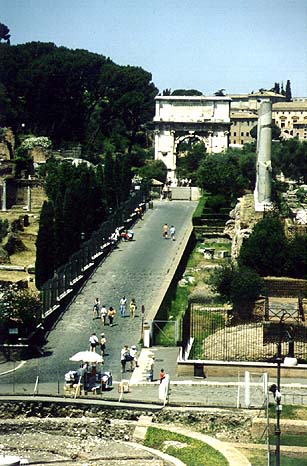The Sacra Via: from the Colosseum
A remark by Varro implies that he considered the Sacra Via to begin
in the Colosseum valley. A century before the construction of the
Flavian Amphitheater (popularly called the Colosseum today), he remarked
(de Lingua Latina 5.47) that the Sacra Via started from a little
shrine (sacellum Streniae) in the Colosseum area and climbed to the top
of the Velia (where the later Arch of Titus, showing below, became the
entrance to the Sacra Via proper), even though general habit at the time
was to use the term only for the descent from the top of the Velia (where
you see the Arch of Titus) and beyond down into the Forum.
 |
This view is from high in the Colosseum looking west toward
the Arch of Titus.
From here, from the now uncertain site of the sacellum Streniae, the
via climbed the Velia, reaching the summit near the Arch of Titus; this
stretch was known as the summa Sacra Via. From the Arch of
Titus it entered the Forum.
Image from VRoma's Forum Project
|
From the little shrine to a goddess of health named Strenia, or possibly
from a bit farther east from something called the Carinae, "keels", a large
structure (oritur caput sacrae viae ab Streniae sacello).
In later times, after the sacellum Streniae was long gone and the Colosseum
was the major landmark, Domitian (late first century CE) built a fountain
known as the Meta Sudans, the conical core of which still exists east of
the Colosseum and which became the eastern terminus of the Sacra Via.
Travelling up this road from the Colosseum area towards the Arch of
Titus you see
-
remains of Hadrian's (second century) large Temple
of Venus and Rome (to return from it, close that window by clicking
the left button in the top of the window), just to the west of the Colosseum,
-
the fourth-century Basilica
of Constantine and Maxentius (here visible from the Palatine across
the Sacra Via; to return from it, close that window, and
-
a Domitian-era pepper warehouse.
More modern buildings have obscured the Republican layout between the Colosseum
and the Arch of Titus.
On the Velia, near the end of this stretch, Varro again referred to
shrines,
-
one on the Velia to Romulus (apud aedem Romuli, LL 5.54) and
-
one near it on the Velia to the Penates (in Velia apud aedem deum Penatium,
LL 5.54).
At the summa Sacra Via, the part beginning at the top of the Velia where
the Arch of Titus now is at the end of the stretch pictured above, was
-
a temple of the Lares,
- the house of the rex sacrorum (Festus 290), and
-
a temple of Jupiter Stator going back to early stories of divine intervention
in battles against Samnites and other early inhabitants of this area.
When the Arch of Titus was built by Domitian to honor Titus' destruction
in 70 CE, the path of the Sacra Via changed to go a little further to the
south through the arch.
There was also an early shrine to Mutunus Tutunus, a fertility deity.
Return to the path at the Arch of Titus by leaving this window by closing
the window.
Sources: Sources:
Oxford Classical Dictionary;
Platner (1911);
S.B. Platner and T. Ashby, A Topographical Dictionary of Ancient Rome,
Oxford UP, 1929
Richard Stillwell, Ed., Princeton Encyclopedia of Classical Sites,
x.v. Roma, Princeton: Princeton U.P, 1976
Varro, de Lingua Latina
Festus
Ernest Nash, A Pictorial Dictionary of Ancient Rome, New York: Praeger,
1962.
